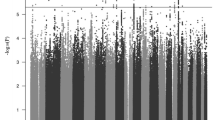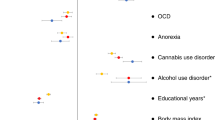Abstract
Objective
The developmental trajectory of attention-deficit hyperactivity disorder (ADHD) is variable. Utilizing a longitudinally assessed sample, we investigated the contribution of susceptibility gene variants, previously implicated through pooled or meta-analyses, to the developmental course of Attention-Deficit Hyperactivity Disorder over time.
Methods
151 children (aged 6–12) who met diagnostic criteria for ADHD were assessed using research diagnostic interviews during childhood and 5 years later in adolescence. Severity was defined as total number of ADHD symptoms at baseline and reassessment. Association with variants at DRD4, DRD5, and the dopamine transporter gene, DAT was analyzed using linear regression.
Results
As expected, affected individuals showed a decline in ADHD severity over time. The DRD4 48 bp VNTR 7-repeat and DRD5 CA(n) microsatellite marker 148 bp risk alleles were associated with persistent ADHD. Those possessing the DRD4 7 repeat risk allele showed less of a decline in severity at reassessment than those without the risk allele.
Conclusions
Those carrying the DRD4 7 risk allele showed greater symptom severity at follow-up and less ADHD reduction over time. These findings support the hypothesis that some susceptibility genes for ADHD also influence its developmental course.
Similar content being viewed by others
References
Angold A, Costello EJ (1995) A test–retest reliability study of child-reported psychiatric symptoms and diagnoses using the child and adolescent psychiatric assessment (CAPA-C). Psychol Med 25:755–762
Angold A, Prendergast M, Cox A, Harrington R, Simonoff E, Rutter M (1995) The child and adolescent psychiatric assessment (CAPA). Psychol Med 25:739–753
Barkley RA (1998) Attention deficit hyperactivity disorder. The Guildford Press, New York
Barkley RA, Smith KM, Fischer M, Navia B (2006) An examination of the behavioral and neuropsychological correlates of three ADHD candidate gene polymorphisms (DRD4 7+, DBH TaqI A2, and DAT1 40 bp VNTR) in hyperactive and normal children followed to adulthood. Am J Med Genet B Neuropsychiatr Genet 141:487–498
Costello EJ, Mustillo S, Erkanli A, Keeler G, Angold A (2003) Prevalence and development of psychiatric disorders in childhood and adolescence. Arch Gen Psychiatry 60:837–844
Curran S, Mill J, Tahir E, Kent L, Richards S, Gould A, Huckett L, Sharp J, Batten C, Fernando S, Ozbay F, Yazgan Y, Simonoff E, Thompson M, Taylor E, Asherson P (2001) Association study of a dopamine transporter polymorphism and attention deficit hyperactivity disorder in UK and Turkish samples. Mol Psychiatry 6:425–428
Daly G, Hawi Z, Fitzgerald M, Gill M (1999) Mapping susceptibility loci in attention deficit hyperactivity disorder: preferential transmission of parental alleles at DAT1, DBH and DRD5 to affected children. Mol Psychiatry 4:192–196
Ding YC, Chi HC, Grady DL, Morishima A, Kidd JR, Kidd KK, Flodman P, Spence MA, Schuck S, Swanson JM, Zhang YP, Moyzis RK (2002) Evidence of positive selection acting at the human dopamine receptor D4 gene locus. Proc Natl Acad Sci USA 99:309–314
El-Faddagh M, Laucht M, Maras A, Vohringer L, Schmidt MH (2004) Association of dopamine D4 receptor (DRD4) gene with attention-deficit/hyperactivity disorder (ADHD) in a high-risk community sample: a longitudinal study from birth to 11 years of age. J Neural Transm 111:883–889
Faraone SV, Biederman J, Mick E (2006) The age-dependent decline of attention deficit hyperactivity disorder: a meta-analysis of follow-up studies. Psychol Med 36:159–165
Faraone SV, Biederman J, Monuteaux MC (2000) Toward guidelines for pedigree selection in genetic studies of attention deficit hyperactivity disorder. Genet Epidemiol 18:1–16
Faraone SV, Doyle AE, Mick E, Biederman J (2001) Meta-analysis of the association between the 7-repeat allele of the dopamine D(4) receptor gene and attention deficit hyperactivity disorder. Am J Psychiatry 158:1052–1057
Faraone SV, Perlis RH, Doyle AE, Smoller JW, Goralnick JJ, Holmgren MA, Sklar P (2005) Molecular genetics of attention-deficit/hyperactivity disorder. Biological Psychiatry 57:1313–1323
Faraone SV, Spencer TJ, Montano CB, Biederman J (2004) Attention-deficit/hyperactivity disorder in adults: a survey of current practice in psychiatry and primary care. Arch Intern Med 164:1221–1226
Ford T, Goodman R, Meltzer H (2003) The British child and adolescent mental health survey 1999: the prevalence of DSM-IV disorders. J Am Acad Child Adolesc Psychiatry 42:1203–1211
Grady DL, Chi HC, Ding YC, Smith M, Wang E, Schuck S, Flodman P, Spence MA, Swanson JM, Moyzis RK (2003) High prevalence of rare dopamine receptor D4 alleles in children diagnosed with attention-deficit hyperactivity disorder. Mol Psychiatry 8:536–545
Holmes J, Lawson D, Langley K, Fitzpatrick H, Trumper A, Pay H, Harrington R, Thapar A (2004) The child attention-deficit hyperactivity disorder teacher telephone interview (CHATTI): reliability and validity. Br J Psychiatry 184:74–78
Holmes J, Payton A, Barrett J, Harrington R, McGuffin P, Owen M, Ollier W, Worthington J, Gill M, Kirley A, Hawi Z, Fitzgerald M, Asherson P, Curran S, Mill J, Gould A, Taylor E, Kent L, Craddock N, Thapar A (2002) Association of DRD4 in children with ADHD and comorbid conduct problems. Am J Med Genet B: Neuropsychiatr Genet 114:150–153
Holmes J, Payton A, Barrett JH, Hever T, Fitzpatrick H, Trumper AL, Harrington R, McGuffin P, Owen M, Ollier W, Worthington J, Thapar A (2000) A family-based and case-control association study of the dopamine D4 receptor gene and dopamine transporter gene in attention deficit hyperactivity disorder. Mol Psychiatry 5:523–530
Kuntsi J, Rijsdijk F, Ronald A, Asherson P, Plomin R (2005) Genetic influences on the stability of attention-deficit/hyperactivity disorder symptoms from early to middle childhood. Biol Psychiatry 57:647–654
Langley K, Turic D, Peirce TR, Mills S, Van Den Bree MB, Owen MJ, O’Donovan MC, Thapar A (2005) No support for association between the dopamine transporter (DAT1) gene and ADHD. Am J Med Genet B Neuropsychiatr Genet 139:7–10
Larsson JO, Larsson H, Lichtenstein P (2004) Genetic and environmental contributions to stability and change of ADHD symptoms between 8 and 13 years of age: a longitudinal twin study. J Am Acad Child Adolesc Psychiatry 43:1267–1275
Leibson CL, Long KH (2003) Economic implications of attention-deficit hyperactivity disorder for healthcare systems. Pharmacoeconomics 21:1239–1262
Li D, Sham PC, Owen MJ, He L (2006) Meta-analysis shows significant association between dopamine system genes and attention deficit hyperactivity disorder (ADHD). Hum Mol Genet 15:2276–2284
Lowe N, Kirley A, Hawi Z, Sham P, Wickham H, Kratochvil CJ, Smith SD, Lee SY, Levy F, Kent L, Middle F, Rohde LA, Roman T, Tahir E, Yazgan Y, Asherson P, Mill J, Thapar A, Payton A, Todd RD, Stephens T, Ebstein RP, Manor I, Barr CL, Wigg KG, Sinke RJ, Buitelaar JK, Smalley SL, Nelson SF, Biederman J, Faraone SV, Gill M (2004) Joint analysis of the DRD5 marker concludes association with attention-deficit/hyperactivity disorder confined to the predominantly inattentive and combined subtypes. Am J Hum Genet 74:348–356
Maher BS, Marazita ML, Ferrell RE, Vanyukov MM (2002) Dopamine system genes and attention deficit hyperactivity disorder: a meta-analysis. Psychiatr Genet 12:207–215
Mill J, Caspi A, Williams BS, Craig I, Taylor A, Polo-Tomas M, Berridge CW, Poulton R, Moffitt TE (2006) Prediction of heterogeneity in intelligence and adult prognosis by genetic polymorphisms in the dopamine system among children with attention-deficit/hyperactivity disorder: evidence from 2 birth cohorts. Arch Gen Psychiatry 63:462–469
Nadder TS, Rutter M, Silberg JL, Maes HH, Eaves LJ (2002) Genetic effects on the variation and covariation of attention deficit-hyperactivity disorder (ADHD) and oppositional-defiant disorder/conduct disorder (Odd/CD) symptomatologies across informant and occasion of measurement. Psychol Med 32:39–53
Price TS, Simonoff E, Asherson P, Curran S, Kuntsi J, Waldman I, Plomin R (2005) Continuity and change in preschool ADHD symptoms: longitudinal genetic analysis with contrast effects. Behav Genet 35:121–132
Purper-Ouakil D, Wohl M, Mouren MC, Verpillat P, Ades J, Gorwood P (2005) Meta-analysis of family-based association studies between the dopamine transporter gene and attention deficit hyperactivity disorder. Psychiatr Genet 15:53–59
Rietveld MJ, Hudziak JJ, Bartels M, van Beijsterveldt CE, Boomsma DI (2004) Heritability of attention problems in children: longitudinal results from a study of twins, age 3–12. J Child Psychol Psychiatry 45:577–588
Shaw P, Gornick MC, Lerch JP, Addington AM, Seal J, Greenstein DK, Sharp W, Evans AC, Giedd JN, Castellanos FX, Rapoport JL (2007) Polymorphisms of the dopamine D4 receptor, clinical outcome and cortical structure in attention-deficit/hyperactivity disorder. Arch Gen Psychiatry 648:921–931
Sherrington R, Mankoo B, Attwood J, Kalsi G, Curtis D, Buetow K, Povey S, Gurling H (1993) Cloning of the human dopamine D5 receptor gene and identification of a highly polymorphic microsatellite for the DRD5 locus that shows tight linkage to the chromosome 4p reference marker RAF1P1. Genomics 18:423–425
Thapar A, Langley K, Asherson P, Gill M (2008) Gene-environment interplay in ADHD and the importance of a developmental perspective. Br J Psychiatry (in press)
Thapar A, O’Donovan M, Owen MJ (2005) The genetics of attention deficit hyperactivity disorder. Hum Mol Genet 14(Spec No. 2):R275–R282
Wang E, Ding YC, Flodman P, Kidd JR, Kidd KK, Grady DL, Ryder OA, Spence MA, Swanson JM, Moyzis RK (2004) The genetic architecture of selection at the human dopamine receptor D4 (DRD4) gene locus. Am J Hum Genet 74:931–944
Whittinger N, Langley K, Fowler T, Thomas H, Thapar A (2008) Clinical precursors of adolescent conduct disorder in children with attention-deficit hyperactivity disorder. J Am Acad Child Adolesc Psychiatry (in press)
Williams NM, Cardno AG, Murphy KC, Jones LA, Asherson P, McGuffin P, Owen MJ (1997) Association between schizophrenia and a microsatellite polymorphism at the dopamine D5 receptor gene. Psychiatr Genet 7:83–85
Acknowledgments
We would like to acknowledge the help and advice of Dr. Valentina Moskvina with the statistical analysis. Financial Support: The first wave of data collection was supported by the Wellcome Trust and ACTION research. The second wave of data was supported by the Department of Health (England). We would also like to acknowledge the support of grants from the National Institute of Mental Health (US NIH) and National Institute of Aging (US NIH) to RKM, Janssen Cilag who funded TAF and the Wellcome Trust who provided a Value in People Award for KL. The authors have no financial disclosures. AT had full access to all of the data in the study and takes responsibility for the integrity of the data and the accuracy of the data analysis.
Author information
Authors and Affiliations
Corresponding author
Rights and permissions
About this article
Cite this article
Langley, K., Fowler, T.A., Grady, D.L. et al. Molecular genetic contribution to the developmental course of attention-deficit hyperactivity disorder. Eur Child Adolesc Psychiatry 18, 26–32 (2009). https://doi.org/10.1007/s00787-008-0698-4
Accepted:
Published:
Issue Date:
DOI: https://doi.org/10.1007/s00787-008-0698-4




